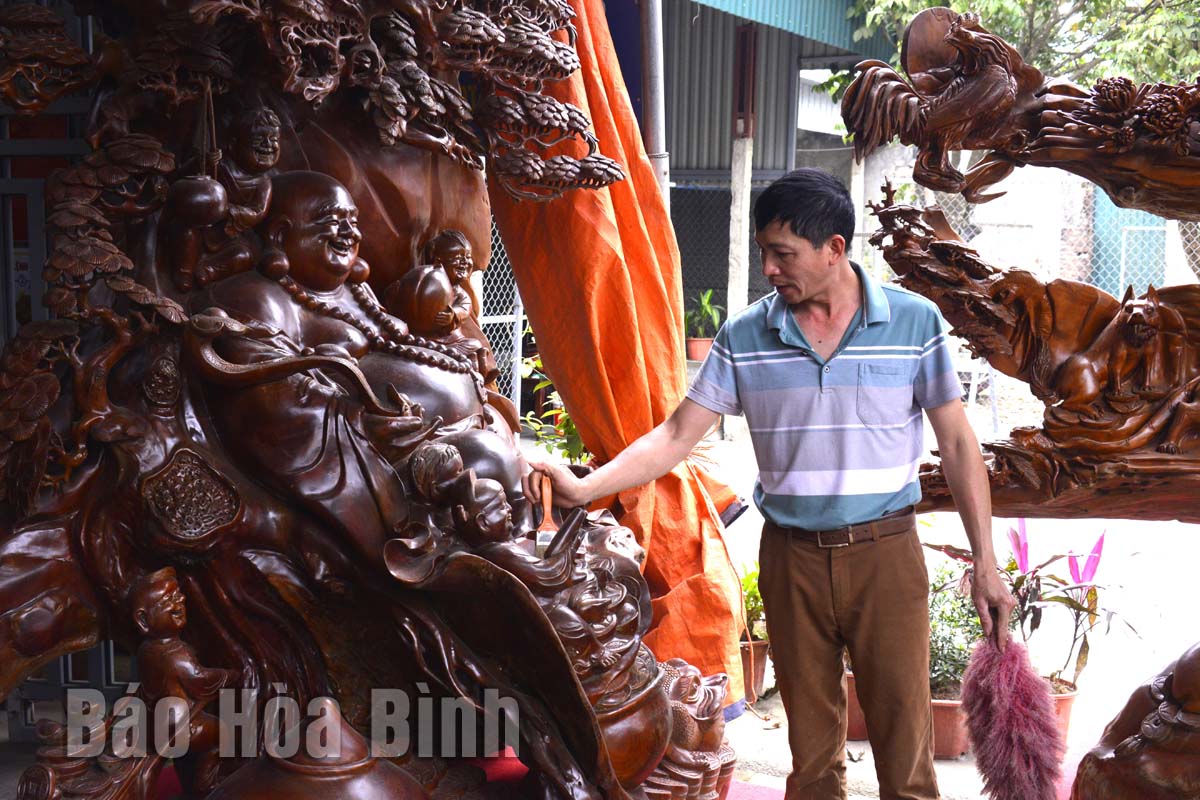
(HBO) – The Lam Son driftwood and ornamental stone craft village is located in Doan Ket hamlet along National Highway 6, very close to the headquarters of the People's Committee of Lam Son Commune. The local production facilities put on display a series of their handmade products of impressive beauty.

Doan Xuan Thanh, the head of the craft village, introduces local fine art crafts.
The crafting of driftwood and ornamental stone has been practiced in Lam Son commune, Luong Son district, since 1994. After nearly 30 years of development, the local production scale has significantly expanded, with products increasingly diversified and quality improved, meeting the demand from customers. In 2017, the locality was recognised by the provincial People's Committee as a craft village of driftwood sculptures and ornamental stone.
The workshop of Doan Xuan Thanh, the head of the craft village, now has three veteran artisans directly engaging in the production of such products as tables, chairs, and mythical and sacred animals. The facility has so far supplied the market with hundreds of items, many of which are made from valuable wood and boast high value in terms of fine art.
According to Thanh, Lam Son is endowed with favourable conditions to develop the handicraft. Since its recognition, the craft village has made a large number of products serving the market. As the pandemic subsides, its operation is gradually recovering.
Thanh’s workshop is among many other large-scale ones in the locality, including those managed by Le Huy Son, Tran Xuan The, and Tran Duy Minh. Out of driftwood, they sculpt statues of gods, animals, and trees, among other shapes. To date, the number of local skilled artisans has amounted to over 100.
The products have been frequently brought to trade fairs in the northern provinces of Hai Duong, Nam Dinh, and Ha Nam, and Hai Phong city as well as a number of others in the southern region. They have so far affirmed their position in the market, contributing to the local sustainable economic restructuring process./.
Hoa Binh province is undergoing a dynamic transformation amid Vietnam’s national digital transition. Building on Poliburo’s Resolution No. 57-NQ/TW on breakthroughs in science, technology, innovation, and national digital transformation, the province has rolled out a wide range of practical action plans. A standout initiative is the "Digital Literacy for All” movement, an effort to ensure that no one is left behind in the digital era.
Hoa Binh province is undergoing a dynamic transformation in the wake of the national digital transformation movement. Building on Resolution No. 57-NQ/TW of the Politburo on breakthroughs in science, technology, innovation, and national digital transformation, the province has implemented a wide range of practical action plans. A standout initiative is the "Digital Literacy for All” movement ambitious effort to ensure that no one is left behind in the digital age.
With a spirit of unity and proactive problem-solving, the Party Committee, the government and the people of Dong Lai Commune (Tan Lac District) have made great strides in implementing the resolutions of the 24th Party Congress of the commune for the 2020 - 2025 term. Focusing on leadership and practical actions, the commune has brought the Party’s resolutions into daily life, creating strong impacts and pushing the local development forward.
Amid the nationwide push for digital transformation, young people in Hoa Binh Province are stepping up as dynamic pioneers, applying technology to enhance Youth Union operations and expand the reach of youth-led initiatives. Through creativity and adaptability, Youth Union organizations at all levels have introduced a series of practical solutions, contributing to modern governance and community development.
In recent years, An Nghia commune, located in Lac Son district, has stepped up administrative reform, focusing on improving the quality and efficiency of its single-window service unit for receiving and processing administrative procedures. These improvements have helped create favourable conditions for local residents and organisations to handle administrative procedures, contributing to the commune’s broader socio-economic development.
The Prime Minister-approved master plan to develop the multi-use value of forests ecosystems through 2030, with a vision to 2050, aims to improve the management and sustainable use of forest resources, create jobs, increase incomes, and improve the living standards of ethnic minorities, people in mountainous and remote areas, forest workers and those living near forests.



